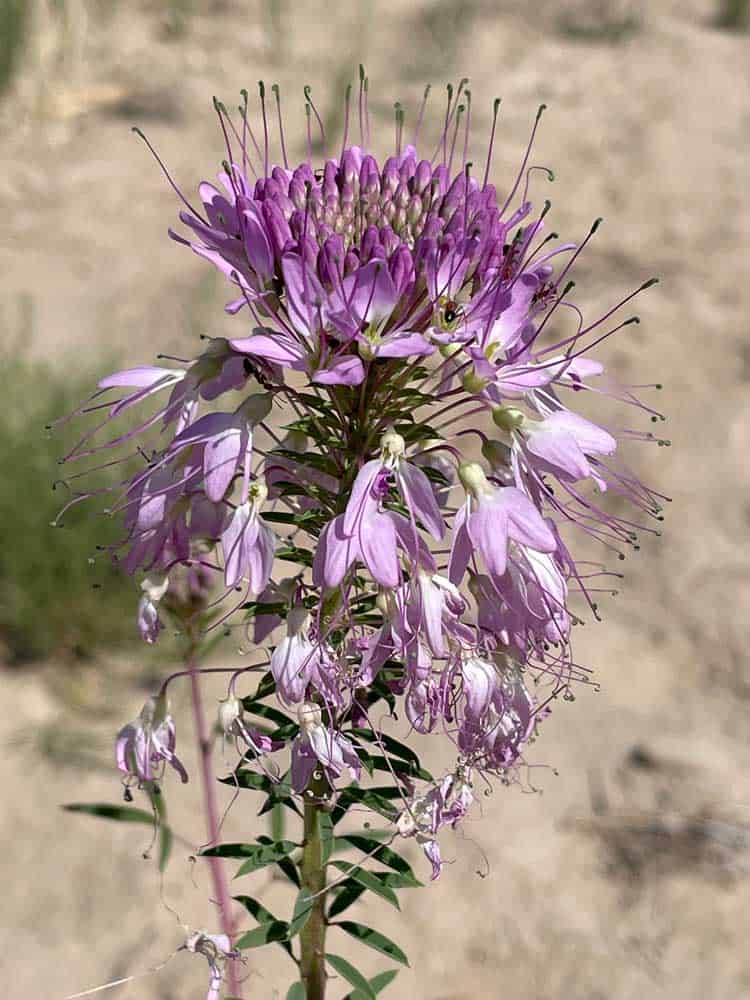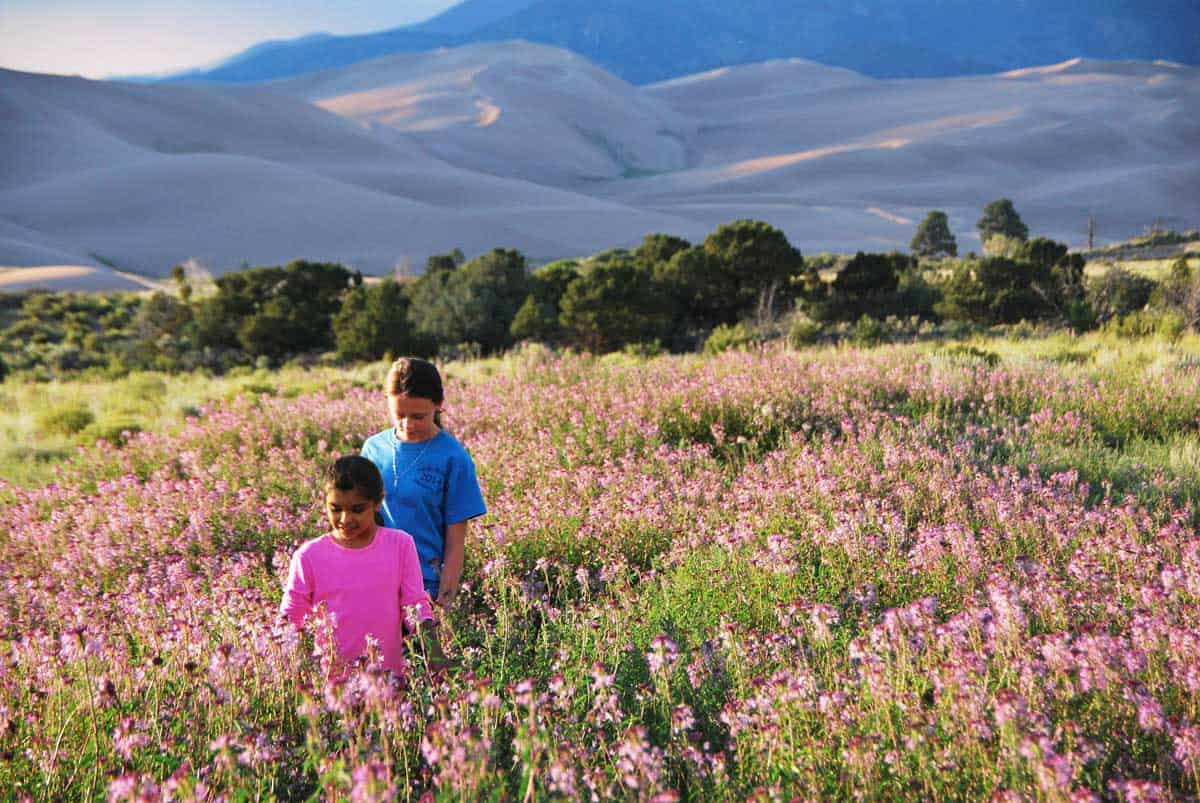Cleomella serrulata is a beautiful, pink-flowered annual herb that can grow up to 4 feet tall. It is commonly found along disturbed sites along roads, meadows, and rangelands in U.S. western and prairie regions. This plant is notable for its attractive pink to lavender flower clusters and plays an important role in supporting local ecosystems through its relationships with invertebrates and animals.
Commonly known as Rocky Mountain beeplant or beeweed, stinking-clover, bee spider-flower, skunk weed, Navajo spinach, and guaco, it’s a species of annual plant in the genus Cleomella. The stem leaves are divided into three linear-eliptic leaflets that are arranged alternately along the stem. The nectar-filled flowers are clustered in elongated racemes near the top portion of the stems and attract a diverse array of pollinators, including bees, butterflies, and wasps. Each flower has four petals and sepals and six long showy stamens. This species has a long blooming season: anytime from May thru September, depending on location and elevation. The fruits are distinctive podlike capsules, up to four inches long, and droop downward from elongated stalks.

This annual plant is truly a keystone species in the habitats where it grows natively across the western and central United States as well as southern Canada. Its striking flowers have evolved an intricate symbiotic pollination relationship with bees and other native insects. Bees are strongly attracted to the flowers and play a crucial role in cross-pollinating Cleome serrulata populations and assisting with fertilization of other plant species growing nearby.
Beyond bees surrounding the elongate spikes, you’ll see the nectar-filled blossoms draw a fascinating array of other invertebrates over the course of the flowering season, providing vital nourishment in the form of pollen and nectar.
Despite having what some might consider an unpleasant odor, which can act as a feeding deterrent for animals, several seed-eating bird species have adapted the ability to consume C. serrulata‘s nutrient-rich seeds and aid in seed dispersal and propagation through their droppings. Thus birds also play an interconnected role in the plant’s life cycle.
Growing Tips
Though it prefers moist alkaline soils, Rocky Mountain Beeplant shows an incredible adaptability to different environments and soil pH levels as well as soil types. The plant is adaptable to poor soil conditions, including soils high in calcium carbonate such as lime and chalk. It is also very drought tolerant. For this reason it is increasingly popular in soil remediation and for planting in year one of site-recovery efforts. The plant is a common sight in various landscapes, from roadsides to prairies, coexisting with species like western wheatgrass and big sagebrush. Because of its eagerness to colonize disturbed areas and soils that many plants cannot tolerate, it’s a great pioneer plant for gardeners and landscapers to use in helping recover depleted and degraded areas. And being an annual, it’s not likely to outcompete hardier perennials in the natural environment.

Germination and Sowing
The seeds require a period of moist cold (cold stratification) before they can germinate. This can be achieved by sowing the seeds directly outdoors in the fall or by stratifying seeds indoors before spring planting. For fall sowing, simply scatter the seeds on the soil surface, as they need light to germinate. For spring planting, mix the seeds with moist sand and store in the refrigerator for 30 days before sowing. Seeds can also be started indoors 6-8 weeks before the last frost of spring. Germination occurs within 30-35 days, but the germination rate may be naturally low.
To enhance germination, ensure you use only dark-colored seeds, as pale ones tend to not be viable. If starting seeds indoors, maintain consistent moisture and a temperature around 65 degrees Fahrenheit. When sowing directly outdoors, either in fall or after stratification in spring, lightly cover the seeds with soil or simply press them into the soil surface, as they require light for germination. Keep the soil evenly moist until germination,
Cleome Serrulata or Rocky Mountain Beeplant Ecosystem and Biodiversity Contributions
Because of its importance to ecosystems and its wide native range covering much of U.S. western and prairie regions and parts of southern Canada and north-central Mexico, as well as its tolerance for a large number of hardiness zones, Rocky Mountain Beeplant is an excellent choice for native plant gardeners.
Pollinator Attraction: Rocky Mountain Beeplant is a significant nectar and pollen source for many pollinators, including bees, butterflies, moths, and hummingbirds. Its vibrant flowers are specifically adapted to attract these insects, offering them sweet nectar.
Butterfly Host Plant: The plant serves as a host for the larvae of certain butterfly species, such as the orange sulfur butterfly (Colias eurytheme). It provides an environment for caterpillars to feed and develop. Another specialized relationship occurs with the checkered white butterfly, whose caterpillars feed exclusively on C. serrulata plants, underlining the plant’s vital place in local food webs.
Seed Dispersal: Once the flowers mature and produce seeds, these become a crucial food source for various birds, including sparrows, finches, and Gambel’s Quail (Callipepla gambelii). These birds assist in dispersing the seeds to new areas.
Beneficial Insects: Beyond bees, Rocky Mountain Beeplant attracts beneficial insects like ladybugs, lacewings, and various wasps, which can help control garden pests. These insects include the Great Golden Digger Wasp (Sphex ichneumoneus), which hunts other insects, and the Masarid Wasp (Pseudomasaris vespoides), known for collecting pollen from desert flowers.
Cleomella serrulata supports a variety of invertebrates and other animal species:
- Bees: Yellow-faced Bees (Hylaeus sp.), Cellophane Bee (Colletes inaequalis), Long-horned Bees (Melissodes sp.), Texas Striped-Sweat Bee (Agapostemon texanus), Alkali Bee (Nomia melanderi), Cactus Bee (Diadasia diminuta), Perdita Minima Bee (Perdita minima), and Wool Carder Bees (Anthidium sp.).
- Birds and Mammals: Gambel’s Quail (Callipepla gambelii), Desert Kangaroo Rat (Dipodomys deserti), Canyon Towhee (Pipilo fuscus), and White-tailed Antelope Squirrel (Ammospermophilus leucurus) feed on its seeds and use the plant for shelter or cover.
- Reptiles: Desert Spiny Lizard (Sceloporus magister) utilizes the plant for shade and hunting.
Traditional Uses and Caution: The plant has been an important cultural plant used by Native Americans and especially southwestern Indian tribes for food, dye, paint designs and traditional medicine, but animals generally avoid it due to its taste and odor. Excessive consumption can lead to nitrate poisoning.
Sources:
(1) Rocky Mountain Bee Plant – US Forest Service. https://www.fs.usda.gov/wildflowers/plant-of-the-week/cleome_serrulata.shtml.
(2) USDA Plants Database. https://plants.usda.gov/home/plantProfile?symbol=CLSE.
(3) Cleome serrulata (Rocky Mountain Beeplant) – Gardenia. https://www.gardenia.net/plant/cleome-serrulata.
(4) USDA Plants Database. https://plants.sc.egov.usda.gov/home/plantProfile?symbol=CLSE.
